93 Most Compelling Workplace Statistics
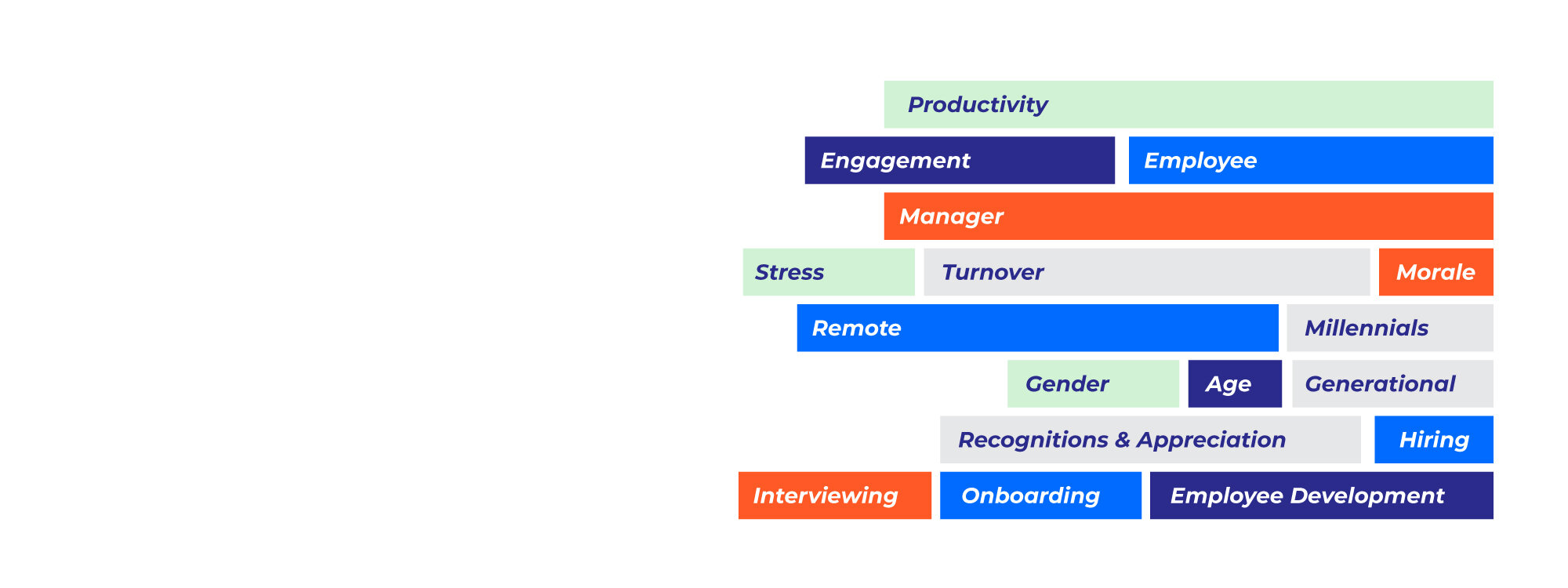
As a manager, you most likely have goals to increase productivity, employee engagement, and job satisfaction, as well as to reduce stress, turnover and performance management issues.
Solving for these lofty goals can prove challenging, but it starts with an understanding of the problem (hence the statistics) and then a willingness to engage in coaching relationships with your team.
In an effort to facilitate meaningful development conversations between managers and employees, we combed through stacks and stacks of workplace research to weed out the inaccurate, outdated and misleading statistics.
What’s left is a compilation of the best current research to provide you with over 90 of the most compelling workplace statistics. These statistics are designed to give you a better understanding of root problems and potential areas for improvement in aspects such as interviewing, productivity, onboarding, and employee-manager relations.
Each statistic references the source we drew it from so you know it's accurate, and since we've reduced the information to the simplest format possible, you can spend more time in conversation with your employees.
How to use these statistics
Every statistic comes with a conversation prompt and an action item.
The Conversation Prompt:
We designed the conversation prompt to be the opening serve in the coaching session. Using that as a beginning, you can find out your employee's beliefs, background, and experiences around the topic mentioned in the statistic. From there, it's up to you to direct the conversation in the way you believe will most benefit your employee.
The Action Item:
Remember, great coaching involves more than just conversation. Use the action item on each card as bite-sized activities your employee can complete in a few minutes, or at most an hour, over the next week. By completing this small action step, your employee can start to practice the ideas you've just talked about. In many cases, the action item from one session may help you generate conversation at the next session.
Table of Contents
-
Productivity
-
Engagement
-
Performance Management and the Employee/Manager Relationship
-
Millennials and Gen-Z
-
Morale
-
Turnover
-
Remote Work
-
Stress
-
Demographic Trends
-
Recognition and Appreciation
-
Employee Development
-
Hiring & Interviewing
-
Onboarding
Let’s dig in!
Statistics on Productivity
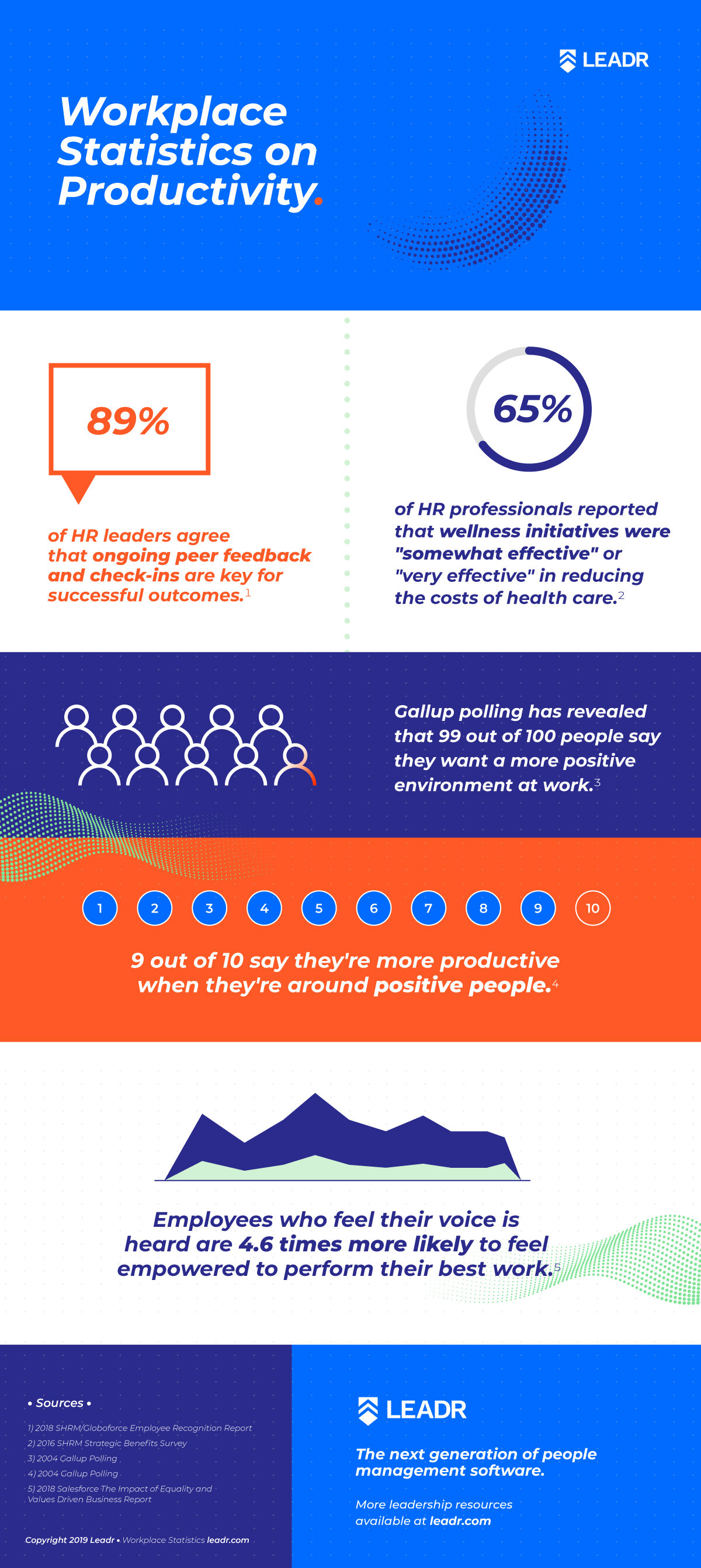
89% of HR leaders agree that ongoing peer feedback and check-ins are key for successful outcomes
-
Source: https://www.globoforce.com/press-releases/globoforce-shrm-human/
-
Conversation Prompt: Are you getting regular, helpful feedback from your peers?
-
Action Item: Get helpful feedback from one peer this week, and give actionable feedback to one peer this week. Write down what was said, when, and by whom so we can discuss it in our next session.
Employees who feel their voice is heard are 4.6 times more likely to feel empowered to perform their best work
-
Source: https://www.salesforce.com/blog/2018/02/why-equality-and-diversity-need-to-be-priorities
-
Conversation Prompt: Tell me about a time that you really felt your voice was heard at work.
-
Action Item: Share with me in writing one thing that you think our company could be doing better.
According to the Centers for Disease Control and Prevention (CDC), "productivity losses from missed work cost employers $225.8 billion, or $1,685 per employee, each year." By carefully planning and designing policies, managing absenteeism and its administration, and tackling the underlying causes (e.g., health issues, employee morale), an organization can significantly reduce the impact of employee absences on its bottom line.
-
Source: https://www.cdc.gov/chronicdisease/resources/publications/aag/workplace-health.html
-
Conversation Prompt: Manager shares a story that begins, "I once took the day off to …"
-
Action Item: Confirm with HR that you are on track to take off all your vacation days and personal days this year.
In 2017 the U.S. Department of Labor (DOL) estimated that almost 3% of an employer's workforce was absent on any given day. The high price of absenteeism affects organizations, even more, when lost productivity, morale and temporary labor costs are considered.
-
Source: https://www.shrm.org/resourcesandtools/tools-and samples/toolkits/pages/managingemployeeattendance.aspx
-
Conversation Prompt: Do you ever feel like skipping work? Tell me about it.
-
Action Item: Do you know our policy and benefit package around personal days or mental health days along with sick days? Research and let’s discuss next week.
A SHRM strategic benefits survey found that about two-thirds (68%) of HR professionals indicated their organization offered some type of wellness program, resource or service to employees. Among these respondents, 65% reported that wellness initiatives were "somewhat effective" or "very effective" in reducing the costs of healthcare; 72% indicated they were "somewhat effective" or "very effective" in improving the overall physical health of their employees.
-
Source: https://www.shrm.org/hr-today/trends-and-forecasting/research-and-surveys/Documents/SHRM-Survey-Findings-Strategic-Benefits-Wellness-Initiatives.pdf
-
Conversation Prompt: Do you have a written plan for fitness and nutrition?
-
Action Item: Write down one specific action you can take this week to improve your mental or physical health. Let's discuss it during our next meeting.
Gallup polling has revealed that 99 out of 100 people say they want a more positive environment at work, and 9 out of 10 say they're more productive when they're around positive people.
-
Source: https://news.gallup.com/businessjournal/12577/Be-Nice-Its-Good-for-Business.aspx
-
Conversation Prompt: Why does a positive attitude matter in the workplace?
-
Action Item: At our next meeting, be ready to answer these questions:
-
What are the behaviors that make you successful in your job?
-
What are behaviors do you see others exhibit that limit their success?
-
Ready to empower your managers with the tools they need to increase productivity at your organization?
Request a demo now.
Statistics on Engagement
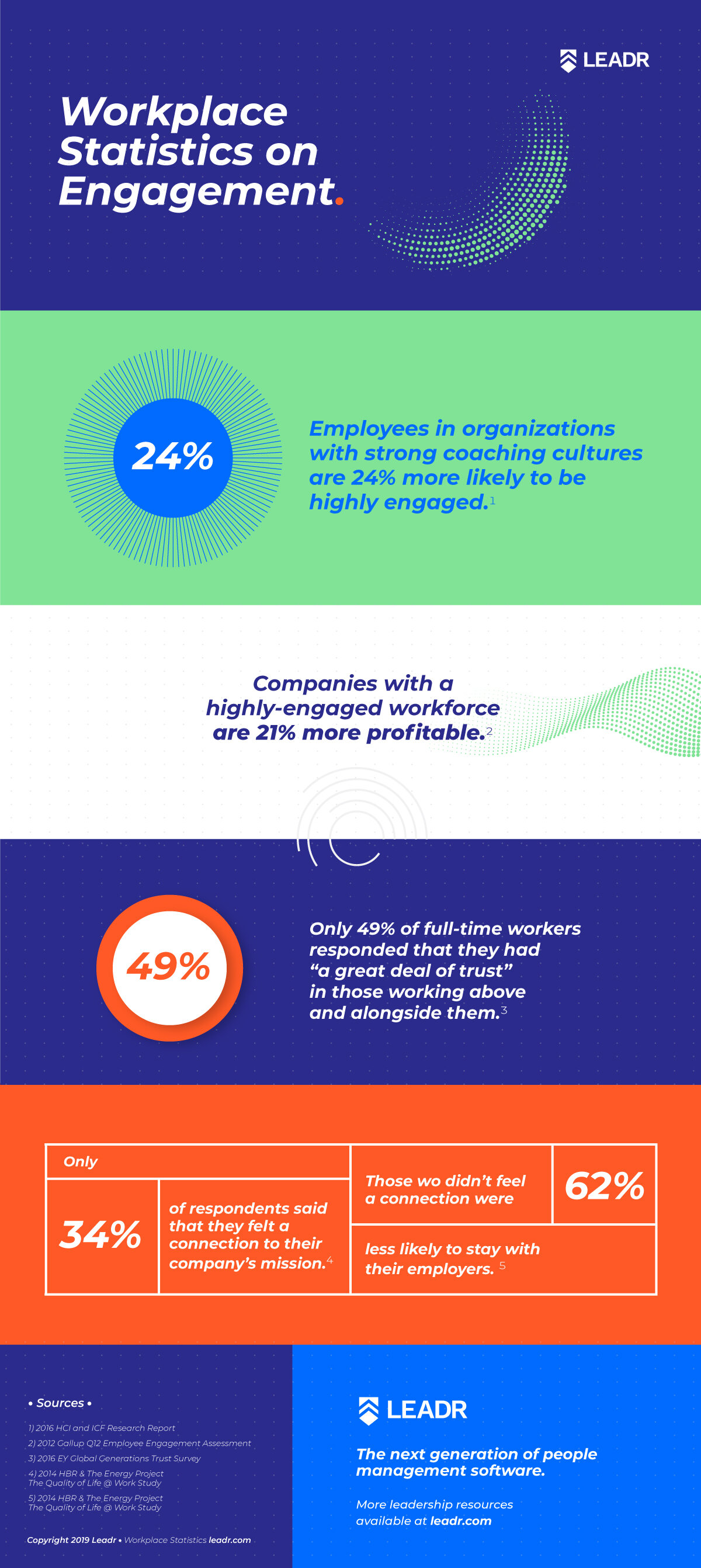
Only 15% of employees worldwide are engaged in their jobs
-
Source: https://www.gallup.com/workplace/238079/state-global-workplace-2017.aspx
-
Conversation Prompt: How would you define "employee engagement?"
-
Action Item: Next week, bring a list of the three regular tasks you find most engaging and the three you find least engaging.
According to a survey by HCI and the International Coach Federation, employees in organizations with strong coaching cultures are 24% more likely to be rated as highly engaged.
-
Source: https://www.careercompasscanada.com/wp-content/uploads/2016/10/2016-Building-a-Coaching-Culture-for-Managers-and-Leaders-Final.compressed.pdf
-
Conversation Prompt: What competencies would you like to develop while you work for this organization?
-
Action Item: Write down one or two specific competencies you could help someone else develop.
Companies with a highly-engaged workforce are 21% more profitable. Employee engagement isn't just about soft, intangible and feelings-based reviews about employee well-being. Employee engagement has a very real impact on business success, and employee engagement should be considered a part of a business strategy. According to Gallup’s meta-analysis, the business or work units that scored the highest on employee engagement showed 21% higher levels of profitability than units in the lowest quartile. Companies with a highly engaged workforce also scored 17% higher on productivity.
-
Source: https://www.gallup.com/workplace/236927/employee-engagement-drives-growth.aspx
-
Conversation Prompt: Why do you think employee engagement has a very real impact on business success?
-
Action Item: Make a note of a time that you were deeply engaged in a project and your engagement had a quantifiable impact. Let's discuss it at our next meeting.
Small firm employees feel far more engaged in their work than their corporate counterparts
-
Source: *The New Employee/Employer Equation Survey was conducted by Harris Interactive, Inc., a leading market research firm, and included responses from a nationwide sample of 7,718 American employees 18 and over.
-
Conversation Prompt: Why do you think small firm employees feel far more engaged in their work than their corporate counterparts?
-
Action Item: One of the reasons employees at small firms feel more engaged may be that they can do more varied and interesting work. Are there some activities beyond your job description you'd like to get more involved in?
Only 49% of full-time workers responded that they had “a great deal of trust” in those working above and alongside them.
-
Source: https://hbr.org/2016/07/a-global-survey-on-the-ambiguous-state-of-employee-trust
-
Conversation Prompt: Who is someone in the office you have a great deal of trust in? Why?
-
Action Item: What's something you have wanted to share with me but were afraid to do? (It may take the employee a week or so to develop and articulate an answer to this question.)
“Employees who felt that their leaders treated them with respect were 63% more satisfied with their jobs, 55% more engaged, 58% more focused, and 110% more likely to stay with their organization.”
-
Source: http://uli.org/wp-content/uploads/ULI-Documents/The-Human-Era-at-Work.pdf
-
Conversation Prompt: What does it mean for someone to treat you with respect?
-
Action Item: Be purposeful about "owning the result" this week. If you make a mistake, admit it right away. If you're responsible for something great happening, don't try to deflect the praise. Tell me about it in next week's meeting.
Employees who work at least 55 hours, compared to those who work 40 hours or less, report feeling 21% less engaged and 27% less focused.
-
Source: http://uli.org/wp-content/uploads/ULI-Documents/The-Human-Era-at-Work.pdf
-
Conversation Prompt: When is the last time you felt overworked?
-
Action Item: Check with HR to make sure you are on track to take all your vacation days this year and that you are not regularly working more than 45 hours a week.
Most companies fall far short of communicating their mission to their employees in a clear and compelling way. Only 34% of respondents said that they felt a connection to their company’s mission, and those who didn’t feel such a connection were 62% less likely to stay with their employers and 45% less engaged.
-
Source: http://uli.org/wp-content/uploads/ULI-Documents/The-Human-Era-at-Work.pdf
-
Conversation Prompt: Can you quote our company's mission statement?
-
Action Item: Write out our company's mission statement in your own words.
The top drivers of employee engagement continue to be belief in and communication from senior leadership and career growth and development.
-
Source: http://newmeasures.com/wp-content/uploads/2019/06/Newmeasures-White-Paper-Trends-in-Employee-Engagement-Final.pdf
-
Conversation Prompt: Which of these two things are most motivating for you? Why?
-
Action Item: What's one specific thing you think I could be doing better as a leader in this company?
Ready to empower your managers with the tools they need to increase engagement at your organization?
Request a demo now.
Statistics on Performance Management and the
Employee/Manager Relationship
Positive behavior change in the areas of time management, faster onboarding, and decision making have all been observed as a result of strategically designed and implemented coaching in organizations.
-
Source: Trenner, L. (2013). Business coaching for information professionals: Why it offers such good value for money in today’s economic climate. Business Information Review, 30 (1), 27-34.
-
Conversation Prompt: If you were hired to be the head of culture at a company — any company — what's the first thing you would do to set up a strong coaching culture there?
-
Action Item: List three ideal outcomes you'd like to see from our coaching sessions.
Hard financial benefits such as increased productivity and work quality have all been observed as a result of strategically designed and implemented coaching in organizations.
-
Source: Trenner, L. (2013). Business coaching for information professionals: Why it offers such good value for money in today’s economic climate. Business Information Review, 30 (1), 27-34.
-
Conversation Prompt: How would you define "coaching" as a role?
-
Action Item: Identify one area in which you would like specific coaching.
Soft, intangible benefits such as decreased stress, increased engagement, improved teamwork and job satisfaction have all been observed as a result of strategically designed and implemented coaching in organizations.
-
Source: Trenner, L. (2013). Business coaching for information professionals: Why it offers such good value for money in today’s economic climate. Business Information Review, 30 (1), 27-34.
-
Conversation Prompt: Tell me about the best coaching experience you ever had. What made it great?
-
Action Item: Determine three actions you could take over the next six months to help develop your leadership skills. Let's create a plan around those.
CEB research has found that more than 9 in 10 managers are dissatisfied with how their companies conduct annual performance reviews, and almost 9 in 10 HR leaders say the process doesn’t yield accurate information.
-
Source: https://www.shrm.org/resourcesandtools/hr-topics/employee-relations/pages/performance-reviews-are-dead.aspx
-
Conversation Prompt: What's the most helpful or unhelpful performance review you've ever undergone?
-
Action Item: In what three areas would you most like feedback at your next performance review?
96% of employees rate empathy as important for companies to demonstrate.
-
Source: https://info.businessolver.com/hubfs/empathy-2018/businessolver-empathy-executive-summary.pdf
-
Conversation Prompt: How would you define empathy?
-
Action Item: Make a note of one specific time this week that you showed empathy to someone else and one time that someone showed it to you. Let's discuss these next time we meet.
Only 2 in 10 employees strongly agree that their performance is managed in a way that motivates them to do outstanding work.
-
Source: https://www.gallup.com/workplace/238064/re-engineering-performance-management.aspx
-
Conversation Prompt: Tell me about a time you did outstanding work, something you're really proud of.
-
Action Item: Write down one thing I can do to help your work move closer to "outstanding." Let's discuss it next time.
30% of employees strongly agree that their manager involves them in goal setting.
-
Source: https://www.gallup.com/workplace/238064/re-engineering-performance-management.aspx
-
Conversation Prompt: What is one goal you are working toward this year?
-
Action Item: Tell me in writing how accomplishing your goals will further the organization toward accomplishing our collective goals this year?
Employees whose managers involve them in goal setting are 3.6x more likely than other employees to be engaged.
-
Source: https://www.gallup.com/workplace/238064/re-engineering-performance-management.aspx
-
Conversation Prompt: How were you involved in setting your goals this year?
-
Action Item: Start keeping a document of ideas for goals you think would be valuable for you to pursue so that you can share it with me when we plan for next year.
21% of employees strongly agree they have performance metrics that are within their control.
-
Source: https://www.gallup.com/workplace/238064/re-engineering-performance-management.aspx
-
Conversation Prompt: What performance metrics are used to evaluate you?
-
Action Item: Find and share one performance metric you'd like to see used to evaluate your work this year.
Only 14% of employees strongly agree that the performance reviews they receive inspire them to improve.
-
Source: https://www.gallup.com/workplace/238064/re-engineering-performance-management.aspx
-
Conversation Prompt: Share with your employee about one particularly unhelpful or uninspiring performance review you received.
-
Action Item: What is one piece of feedback you would find particularly helpful to receive during a performance review?
A Harvard Business Review survey found that while 58% of people trust strangers, only 42% trust their own boss.
-
Source: Segalla (2009)
-
Conversation Prompt: What are the top 3 characteristics you look for when deciding if a person is trustworthy or not?
-
Action Item: In our next meeting, please let me know which one of the three characteristics you named you see most, or least, prominently in me.
The three leadership characteristics that had the biggest impact on all performance variables were 1) treating employees with respect, 2) recognizing and appreciating them, and 3) being positive and optimistic.
-
Source: http://uli.org/wp-content/uploads/ULI-Documents/The-Human-Era-at-Work.pdf
-
Conversation Prompt: Tell me about a time you felt that our company particularly appreciated you.
-
Action Item: What is one way we could better show our appreciation for your contributions here?
Employees who felt their leaders treated them with respect were 63% more satisfied with their jobs, 55% more engaged, 58% more focused, and 110% more likely to stay with their organization.
-
Source: http://uli.org/wp-content/uploads/ULI-Documents/The-Human-Era-at-Work.pdf
-
Conversation Prompt: What does it mean to treat someone with respect? How is it more than simply being "nice?"
-
Action Item: When you see a leader in our company being especially respectful this week, make a note of it. Let's discuss what happened and your thoughts about it at our next session.
Only 21% of our survey respondents told us that their leaders model sustainable work practices.
-
Source: http://uli.org/wp-content/uploads/ULI-Documents/The-Human-Era-at-Work.pdf
-
Conversation Prompt: What do you think this survey means by "sustainable work practices?"
-
Action Item: Write down one way our organization could help you meet your physical, spiritual, emotional, or mental health needs.
32% of employees say they have to wait more than three months to receive feedback from their managers.
-
Source: https://www.officevibe.com/state-employee-engagement
-
Conversation Prompt: Why does it take managers so long to provide feedback?
-
Action Item: Create a priority system for me so I know the things you want immediate feedback on, the things that can wait a week or two, and the things that can wait for quarterly or annual conversations.
Ready to empower your managers with the tools they need to improve relationships with employees at your organization? Request a demo now.
Statistics on Millennials and Gen-Z
“Burnout affects millennial retention: 84% of millennials say they have experienced burnout at their current job, compared to 77% of all respondents. Nearly half of millennials say they have left a job specifically because they felt burned out, compared to 42% of all respondents.”
-
Source: https://www2.deloitte.com/us/en/pages/about-deloitte/articles/burnout-survey.htm
-
Conversation Prompt: Share a story about a time you burned out or almost burned out and what happened.
-
Action Item: If you were managing an employee who exhibiting signs of burnout, what would you do?
47% of millennials started looking for another job after receiving their performance review results.
-
Source: https://news.adobe.com/press-release/corporate/performance-review-peril-adobe-study-shows-office-workers-waste-time-and
-
Conversation Prompt: Tell me about a time you went through a particularly difficult performance review. How did it make you feel?
-
Action Item: If you were managing an employee whose performance fell short of expectations, how would you handle the situation?
Among Millennials, around four-in-ten (39%) of those ages 25 to 37 have a bachelor’s degree or higher, compared with just 15% of the Silent Generation, roughly a quarter of Baby Boomers and about three-in-ten Gen Xers (29%) when they were the same age.
-
Source: https://www.pewsocialtrends.org/essay/millennial-life-how-young-adulthood-today-compares-with-prior-generations/
-
Conversation Prompt: Why did you make the educational choice you did after high school? Would you make the same choice again if you could get a do-over?
-
Action Item: What unique contributions does your educational background make to your work here? Let's discuss the connections between your degree and your job when we meet again.
Millennials number about 73 million and are overtaking Baby Boomers as the largest living adult generation. Although a greater number of births underlie the Baby Boom generation, Millennials will outnumber Boomers in part because immigration has been boosting their numbers.
-
Source: https://www.pewsocialtrends.org/essay/millennial-life-how-young-adulthood-today-compares-with-prior-generations/
-
Conversation Prompt: How do you think Millennials will change the workplace?
-
Action Item: What's one specific thing you can do to help bridge generational gaps in our company?
“Looking ahead at the next generation, early benchmarks show Generation Z (those ages 6 to 21 in 2018) is on track to be the nation’s most diverse and best-educated generation yet. Nearly half (48%) are racial or ethnic minorities. And while most are still in K-12 schools, the oldest Gen Zers are enrolling in college at a higher rate than even Millennials were at their age.”
-
Source: https://www.pewsocialtrends.org/essay/millennial-life-how-young-adulthood-today-compares-with-prior-generations/
-
Conversation Prompt: How do you think Gen Z will change the workplace?
-
Action Item: If you were a manager, how would you celebrate and encourage diversity in idea sharing, hiring, and promotion?
“Millennials are always on their smartphones—no surprise there. They own, on average, 7.7 connected devices and use 3.3 each day.”
-
Source: https://theblog.adobe.com/sick-hearing-millennials-read
-
Conversation Prompt: When did you get your first smartphone?
-
Action Item: How can you use your smartphone in ways that improve your work?
As of 2011, Millennials launched almost 160,000 startups, per month, and made up nearly one-third of all entrepreneurs in the U.S.
-
Source: 2011 The Ewing Marion Kauffman Foundation and the Young Invincibles
-
Conversation Prompt: Why do you think Millennials are so entrepreneurial?
-
Action Item: What new program or idea would you like to start and manage in our office?
Millennials now make up 50% of the workforce and bring a strong preference for the immediate recognition of accomplishments.
-
Source: https://www.lvb.com/managing-millennials-it%c2%92s-all-about-immediate-recognition/
-
Conversation Prompt: Do you think providing immediate recognition for accomplishments is helpful or harmful in the long term? Why?
-
Action Item: How could we better create a system for sending and receiving immediate feedback? Think of a few ideas and let’s discuss next week.
Millennials prioritize the ability to travel, with 60% saying it’s one of the primary reasons they work, second only to paying for basic necessities (82%) and ahead of saving for retirement (55%) and paying off debt (50%).
-
Source: https://www.flexjobs.com/blog/post/survey-finds-varying-attitudes-millennials-older-workers-about-key-workplace-issues/ (do we trust this source?)
-
Conversation Prompt: What are the primary reasons you work?
-
Action Item: Imagine you are conducting a job interview, and you want to better understand the interviewee’s work motivations. What questions would you ask?
Ready to empower your managers with the tools they need to bridge the generational gap at your organization?
Request a demo now.
Statistics on Morale
“Companies should consider workplace culture, not just well-being programs: One in four professionals say they never or rarely take all of their vacation days. The top driver of burnout cited in the survey is the lack of support or recognition from leadership, indicating the important role that leaders play in setting the tone.”
-
Source: https://www2.deloitte.com/us/en/pages/about-deloitte/articles/burnout-survey.html
-
Conversation Prompt: What do you think about employees who use all their vacation days?
-
Action Item: If you were a manager, how would you encourage your employees to take time off?
Employee morale can affect an employer's absenteeism rate: Organizations with good or very good morale experience a lower rate of unscheduled absences than those reporting poor or fair morale. Likewise, the effect of morale on how well absence control programs work is reflected across the board. Overall, organizations with good or very good morale rate their absence control policies and work/life programs as more effective than do their counterparts with poor or fair morale.
-
Source: https://www.shrm.org/resourcesandtools/tools-and-samples/toolkits/pages/managingemployeeattendance.aspx
-
Conversation Prompt: How would you rate your morale right now? Has it increased or decreased in the last month?
-
Action Item: What do you think would improve morale in our office? Let’s discuss your ideas next week.
A decade of research proves that happiness raises nearly every business and educational outcome: raising sales by 37%, productivity by 31%, and accuracy on tasks by 19%, as well as a myriad of health and quality of life improvements.
-
Source: https://hbr.org/2011/06/the-happiness-dividend
-
Conversation Prompt: What do you think makes people happy at work?
-
Action Item: Write down three things you can control that would make you happier at work. Choose one. Make it happen.
Across America, 45% of workers say they are either satisfied or extremely satisfied with their jobs.
-
Source: *The New Employee/Employer Equation Survey was conducted by Harris Interactive, Inc., a leading market research firm, and included responses from a nationwide sample of 7,718 American employees 18 and over.
-
Conversation Prompt: What do you think is the key variable that makes people either satisfied or unsatisfied with their jobs?
-
Action Item: Consider what it would take for you to say you are "extremely satisfied" with your job. Write it down. Let's discuss it next week.
Only 20% of employees feel very passionate about their jobs
-
Source: *The New Employee/Employer Equation Survey was conducted by Harris Interactive, Inc., a leading market research firm, and included responses from a nationwide sample of 7,718 American employees 18 and over.
-
Conversation Prompt: What’s something that, when immersed in it, you lose track of time?
-
Action Item: Identify a new skill you'd like to learn this year, something that would help kindle your passion for your job.
33% of employees believe they have reached a dead-end in their career
-
Source: *The New Employee/Employer Equation Survey was conducted by Harris Interactive, Inc., a leading market research firm, and included responses from a nationwide sample of 7,718 American employees 18 and over.
-
Conversation Prompt: Sometimes people feel like they've reached a dead end when they haven't. How can you tell a legitimate dead-end from a place you just need to push through?
-
Action Item: Read The Dip: A Little Book That Teaches You When to Quit by Seth Godin.
21% of employees are eager to change careers
-
Source: *The New Employee/Employer Equation Survey was conducted by Harris Interactive, Inc., a leading market research firm, and included responses from a nationwide sample of 7,718 American employees 18 and over.
-
Conversation Prompt: Share with your employee a time you either changed careers or thought about changing careers.
-
Action Item: Write out your personal vision for where you see yourself in one, three, and five years. Let's discuss at our next session.
Ready to empower your managers with the tools they need to increase morale at your organization?
Request a demo now.
Statistics on Turnover
“A Watson-Wyatt Reward Plan Survey of 614 employers with 3.5 million employees showed that the average turnover rate of employers with a clear reward strategy is 13% lower than that of organizations without one.”
-
Source: Watson-Wyatt Reward Plan Survey
-
Conversation Prompt: Do you feel like our company does a good job of rewarding your performance?
-
Action Item: Identify the top three behaviors you think should be rewarded at our company.
“Gallup’s study of nearly five million employees reveals that an increase in recognition and praise in an organization can lead to lower turnover, higher customer loyalty and satisfaction scores, and increases in overall productivity.”
-
Source: Gallup
-
Conversation Prompt: Tell me about a time you thought you did something that deserved recognition but didn't receive it.
-
Action Item: Write down three non-monetary rewards you would find effective motivators as an employee.
According to Gallup's 2017 State of the American Workplace report, 51% of currently employed adults in the U.S. say they are searching for new jobs or watching for new job opportunities. What's more, they are optimistic about their chances: 47% of workers say now is a good time to find a quality job.
-
Source: https://www.gallup.com/workplace/236216/tomorrow-half-company-quitting-win-back.aspx
-
Conversation Prompt: What do you think is the number one reason people leave our company for another place to work?
-
Action Item: Identify one action you could take that would help our workplace retain more employees.
According to Gallup analytics, 91% of employees say the last time they changed jobs, they changed companies to do so. And employees still leave organizations that they believe in, where they love the pay and perks, and where they have been productive. The reason? Many people leave because of bad managers.
-
Source: https://www.gallup.com/workplace/236216/tomorrow-half-company-quitting-win-back.aspx
-
Conversation Prompt: Have you ever left a workplace due to a bad manager? Can you tell me about that?
-
Action Item: Imagine that you are a manager, and you realize an employee is searching for another job because they don't like working for you. How would you handle the situation? Let's discuss at the next meeting.
A lack of recognition remains one of the most common reasons why employees leave an organization.
-
Source: https://www.gallup.com/workplace/236216/tomorrow-half-company-quitting-win-back.aspx
-
Conversation Prompt: How would you most like to be recognized for your accomplishments?
-
Action Item: Consider keeping a kudos document. Note your accomplishments on it as you have them. Share the document with me.
58% said they would take a job with a competing company if the new company had a better culture than the current one.
-
Source: https://resources.speakap.com/hubfs/resources/en/Research%20Study%20-%20The%20Culture%20Factor%20-%20Improving%20Employee%20Loyalty%20&%20Relationships.pdf
-
Conversation Prompt: What does a great office culture look like to you?
-
Action Item: Identify one specific way you could help boost our office culture and do it this week. Let me know what it was at our next session.
Ready to empower your managers with the tools they need to reduce stress at your organization?
Request a demo now.
Statistics on Remote Work
“Upwork, the largest freelancing website, today released the results of its second annual Future Workforce Report, which explores hiring behaviors of over 1,000 U.S. managers. As companies struggle to fill the skills gap, they’re embracing agile, remote teams to get work done. Nearly two-thirds (63%) of companies today have remote workers, yet a majority lack remote work policies.”
-
Source: https://www.upwork.com/press/2019/03/05/third-annual-future-workforce-report/
-
Conversation Prompt:
-
(For companies that don't have a remote work policy) Do you have experience with remote work at a previous employer? Tell me about how that worked.
-
(For companies that do have a remote work policy) What do you like best about our remote work policy? What would you change?
-
-
Action Item:
-
(For companies that do have a remote work policy) Check with HR to make sure you are taking full advantage of our remote work policy.
-
(For companies that don't have a remote work policy) Would you be interested in serving on a team that researched and recommended a remote work policy for our office?
-
Employed Americans may be more open to a job that’s further from home but offers remote work capabilities, rather than a job close to home but mandates more consistent on-site work. Over 2 in 5 employed Americans (42%) would switch jobs for a flexible work environment, while less than one quarter (24%) would switch for a better commute.
-
Source: https://www.globenewswire.com/news-release/2018/04/11/1468489/0/en/Yoh-Survey-Excluding-a-Raise-Flexible-Work-Environment-and-Better-Benefits-Top-the-Reasons-Employed-Americans-Would-Accept-a-New-Job-Offer.html
-
Conversation Prompt: Would you rather have a shorter commute or a more flexible work environment?
-
Action Item: Workplace flexibility can mean a lot of things from time and telecommuting to job sharing and self-management. In what area would you like to have a more flexible work life? Let's discuss next time.
Statistics on Workplace Burnout and Stress
“Employee burnout has no boundaries: 91% of respondents say having an unmanageable amount of stress or frustration negatively impacts the quality of their work. 83% of respondents say burnout from work can negatively impact their personal relationships.”
-
Source: https://www2.deloitte.com/us/en/pages/about-deloitte/articles/burnout-survey.html
-
Conversation Prompt: What situations create stress in the workplace for you?
-
Action Item: What is one stress management technique you have not yet tried? Use it this week, and let me know how it works for you.
"Passion may not prevent workplace stress: 87% of professionals surveyed say they have passion for their current job but 64% say they are frequently stressed, dispelling the myth that passionate employees are immune to stress or burnout.”
-
Source: https://www2.deloitte.com/us/en/pages/about-deloitte/articles/burnout-survey.html
-
Conversation Prompt: Have you ever burned out on something you were once passionate about?
-
Action Item: Identify one new boundary you could set that wouldn't limit your passion but would forestall possible burnout. (Example: Not checking emails between 8:00 pm and 8:00 am)
“Many companies may not be doing enough to minimize burnout: Nearly 70% of professionals feel their employers are not doing enough to prevent or alleviate burnout within their organization. 21% of respondents say their company does not offer any programs or initiatives to prevent or alleviate burnout.”
-
Source: https://www2.deloitte.com/us/en/pages/about-deloitte/articles/burnout-survey.html
-
Conversation Prompt: What does our company do that helps prevent or alleviate burnout?
-
Action Item: If we were to do a team activity to help us have some fun, what could we do? Would you be willing to help me plan it?
83% of US workers suffer from work-related stress.
-
Source: https://www.stress.org/42-worrying-workplace-stress-statistics
-
Conversation Prompt: What causes people to suffer from work-related stress?
-
Action Item: Watch for a time you self-impose work stress this week. Let's talk about it at our next session.
“78% of full-time workers said they live paycheck-to-paycheck, up from 75% last year, according to a recent report from CareerBuilder.”
-
Source: http://press.careerbuilder.com/2017-08-24-Living-Paycheck-to-Paycheck-is-a-Way-of-Life-for-Majority-of-U-S-Workers-According-to-New-CareerBuilder-Survey
-
Conversation Prompt: Why do you think the number of people living paycheck-to-paycheck is increasing?
-
Action Item: Is there any resource our company could provide to help our team better manage their personal finances?
Top sources of workplace stress: Heavy workload/looming deadlines (33%), Unrealistic expectations of managers (22%), Attaining work-life balance (22%), Coworker conflicts (15%). (Accountemps)
-
Source: https://www.prnewswire.com/news-releases/the-heat-is-on-six-in-10-employees-report-increased-work-stress-300401103.html
-
Conversation Prompt: What is a source of workplace stress for you?
-
Action Item: Identify one strategy you could use to reduce workplace stress this week. Let me know what it is and how it worked for you.
Ready to empower your managers with the tools they need to reduce burnout and stress at your organization?
Request a demo now.
Statistics on Demographic Trends
Parental leave survey: Deloitte’s external workplace survey on parental leave found that more than one-third of men and women surveyed think that taking parental leave would put their job in jeopardy.
-
Source: https://www2.deloitte.com/us/en/pages/about-deloitte/articles/burnout-survey.html
-
Conversation Prompt: What are our HR policies on different types of leave?
-
Action Item: If you were a manager, how would you encourage soon to be parents on your team to take leave if they wanted to take it?
“Based on results from Gallup’s Global Emotions report, 65% of the 30-49 group experiences stress. Americans aged 15-29 are right behind them with 64%, while 44% of people older than 50 reported feeling stressed out.”
-
Source: https://www.gallup.com/analytics/248906/gallup-global-emotions-report-2019.aspx
-
Conversation Prompt: What causes you to feel stressed out at work?
-
Action Item: Find one new stress management technique. Implement it. Let me know how it works for you.
Older workers are the most satisfied and the most engaged in their work.
-
Source: *The New Employee/Employer Equation Survey was conducted by Harris Interactive, Inc., a leading market research firm, and included responses from a nationwide sample of 7,718 American employees 18 and over.
-
Conversation Prompt: What things could be learned from this statistic?
-
Action Item: How could you apply this conversation to your job or personal life?
Younger workers are the most distressed and they feel the least amount of loyalty to their employers
-
Source: *The New Employee/Employer Equation Survey was conducted by Harris Interactive, Inc., a leading market research firm, and included responses from a nationwide sample of 7,718 American employees 18 and over.
-
Conversation Prompt: What things do you think contribute to younger workers potentially feeling more stressed and less loyal?
-
Action Item: What is one specific thing I can do to help you feel less stressed?
“According to our research, women globally were even more likely than men to be majorly influenced by a low level of trust, with more people saying they would look for another job (women 44%, men 40%) or make less of an effort to do quality work (26% and 24%) due to low trust. Women also were more likely than men to cite pay and promotion opportunities (61% and 52%) and a diverse environment (42% and 33%) as “very important” elements for being able to trust their employers.”
-
Source: https://hbr.org/2016/07/a-global-survey-on-the-ambiguous-state-of-employee-trust
-
Conversation Prompt: Do you feel a high level of trust in our organization right now? Has it gone up or down?
-
Action Item: Think of one thing I can do for you to give you more trust in our organization.
Statistics on Recognition and Appreciation
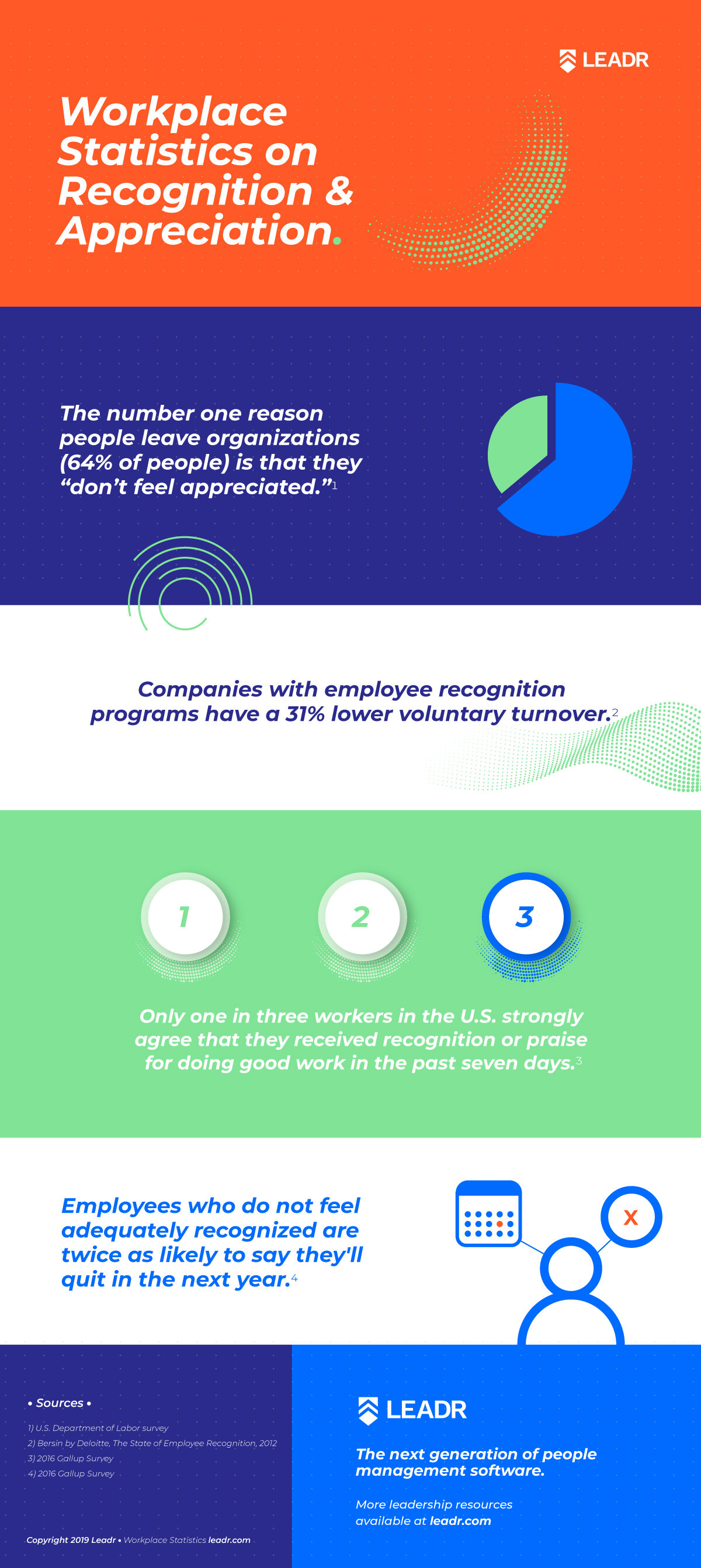
U.S. Department of Labor statistics show the number one reason people leave organizations (64% of people) is that they “don’t feel appreciated.”
-
Source: U.S. Department of Labor survey
-
Conversation Prompt: Tell me about a time you felt really appreciated?
-
Action Item: Make a point to show appreciation to a member of our team this week. Send me an email to let me know who it was and how you showed appreciation to them.
“Research firm Watson and Wyatt has asked employees to identify “very significant” motivators of performance, and 66% said “appreciation.”
-
Source: https://d1yuw6g9r4vq74.cloudfront.net/assets/Resources/White_Paper_Performance_Accelerated.pdf
-
Conversation Prompt: Why is appreciation a greater motivator of performance than pay?
-
Action Item: Send a letter of appreciation to a colleague this week.
Companies with employee recognition programs have a 31% lower voluntary turnover.
-
Source: https://www2.deloitte.com/us/en/pages/human-capital/topics/bersin-insights-and-services-for-hr.html
-
Conversation Prompt: If employee recognition programs are this important, why do so many of them falter and fade away?
-
Action Item: Let me know of a colleague who deserves recognition this week and recommend a way to provide that effectively.
50% of employees believe being thanked by managers improves the relationship and build trust with their higher-ups.
-
Source: http://www.eadion.com/site/uploads/OCT-Performance-Recognition-White-Paper-Intl-Updated-2014-01-07.pdf
-
Conversation Prompt: What would it take to incorporate gratitude more fully into our workplace culture?
-
Action Item: Bring me five ideas for encouraging gratitude among our team members.
The most memorable recognition comes most often from an employee's manager (28%), followed by a high-level leader or CEO (24%), the manager's manager (12%), a customer (10%) and peers (9%). Worth mentioning, 17% cited "other" as the source of their most memorable recognition.
-
Source: https://www.gallup.com/workplace/236441/employee-recognition-low-cost-high-impact.aspx
-
Conversation Prompt: Tell me about a time you received meaningful recognition at work. Who did it come from? What happened?
-
Action Item: Are there ways I can better recognize the contributions you make to the team? Let's discuss next time we meet.
When asked what types of recognition were the most memorable, respondents emphasized six methods in particular -- and money isn't the only (or the top) form of recognition: public recognition or acknowledgment via an award, certificate of commendation, private recognition from a boss, peer or customer, receiving or obtaining a high level of achievement through evaluations or reviews, promotion or increase in scope of work or responsibility to show trust, monetary awards such as a trip, prize or pay increase personal satisfaction or pride in work.
-
Source: https://www.gallup.com/workplace/236441/employee-recognition-low-cost-high-impact.aspx
-
Conversation Prompt: What's the most memorable type of recognition for you?
-
Action Item: Tell me one way you'd like to be recognized for your accomplishments this year.
According to Gallup's analysis, only one in three workers in the U.S. strongly agree that they received recognition or praise for doing good work in the past seven days.
-
Source: https://www.gallup.com/workplace/236441/employee-recognition-low-cost-high-impact.aspx
-
Conversation Prompt: Have you received recognition or praise for doing good work in the past seven days?
-
Action Item: In the next seven days, recognize or praise one of your colleagues for doing good work.
Employees who do not feel adequately recognized are twice as likely to say they'll quit in the next year.
-
Source: https://www.gallup.com/workplace/236441/employee-recognition-low-cost-high-impact.aspx
-
Conversation Prompt: Why do you think there is a strong connection between retention and employee appreciation?
-
Action Item: Determine what "adequate recognition" would mean for you. Let's discuss next week.
Job security, health care coverage and professional development are valued above additional compensation.
-
Source: *The New Employee/Employer Equation Survey was conducted by Harris Interactive, Inc., a leading market research firm, and included responses from a nationwide sample of 7,718 American employees 18 and over.
-
Conversation Prompt: Do you believe the statistics that say employees value job security, health care coverage and professional development over non-monetary rewards?
-
Action Item: Spend time thinking about the one thing you would most like to receive from this company beyond your paycheck as a reward for your work. Let me know what that is.
Ready to empower your managers with the tools they need to improve recognition and appreciation at your organization? Request a demo now.
Statistics on Employee Development
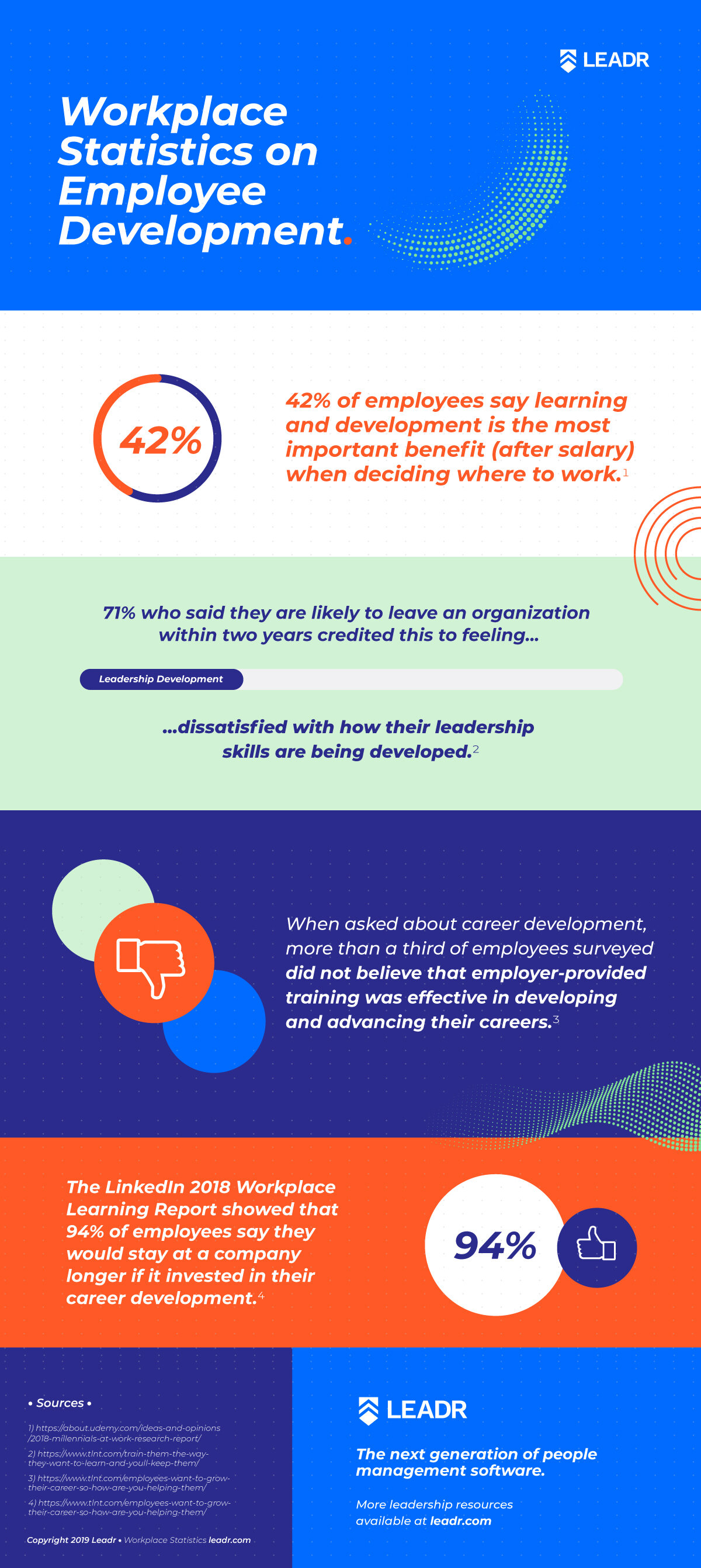
42% of employees say learning and development is the most important benefit (after salary) when deciding where to work.
-
Source: https://about.udemy.com/ideas-and-opinions/2018-millennials-at-work-research-report/
-
Conversation Prompt: What's the most important benefit an employer can offer you?
-
Action Item: What professional skill would you most like to develop this year?
“Deloitte’s 2016 Millennial Survey reported that the 71% who said they are likely to leave an organization within two years credited this to feeling dissatisfied with how their leadership skills are being developed.”
-
Source: https://www.tlnt.com/train-them-the-way-they-want-to-learn-and-youll-keep-them/
-
Conversation Prompt: How would you rate your leadership skills?
-
Action Item: Find a leadership self assessment tool online and take it. Send me the results.
Saba’s 2017 State of Employee Engagement Report found that when asked about career development, more than a third of employees surveyed did not believe that employer-provided training was effective in developing and advancing their careers.
-
Source: https://www.tlnt.com/employees-want-to-grow-their-career-so-how-are-you-helping-them/
-
Conversation Prompt: Have you ever taken a particularly bad employer-provided training at another workplace? Tell me about it.
-
Action Item: Identify a training program you would like to go through this year.
The LinkedIn 2018 Workplace Learning Report showed that 94% of employees say they would stay at a company longer if it invested in their career development.
-
Source: https://www.tlnt.com/employees-want-to-grow-their-career-so-how-are-you-helping-them/
-
Conversation Prompt: How do you feel about how your career is developing here at our company?
-
Action Item: What is one thing I can do for you that I'm not already doing to help you develop your career?
Ready to empower your managers with the tools they need to improve employee development at your organization? Request a demo now.
Statistics on Hiring & Interviewing
95% of organizations of all sizes admit to making bad hires every year, according to Brandon Hall Group’s 2015 Talent Acquisition Study.
-
Source: https://b2b-assets.glassdoor.com/the-true-cost-of-a-bad-hire.pdf
-
Conversation Prompt: What do you think a "bad hire" means?
-
Action Item: Write up a list of screening criteria you would use when interviewing potential candidates.
Organizations that lack a standard interview process are five times as likely to make a bad hire.
-
Source: https://b2b-assets.glassdoor.com/the-true-cost-of-a-bad-hire.pdf.
-
Conversation Prompt: What was your interview process like here?
-
Action Item: If you could redesign the interview process for your position, what would you change? Let’s discuss next week.
Organizations that invest in a strong candidate experience improve their quality of hires by 70%
-
Source: https://b2b-assets.glassdoor.com/the-true-cost-of-a-bad-hire.pdf.
-
Conversation Prompt: What do you think is "a strong candidate experience?"
-
Action Item: Send me three bullet points stating what would improve the candidate experience for our company.
Organizations that invest in employer branding are three times more likely to make a quality hire.
-
Source: https://b2b-assets.glassdoor.com/the-true-cost-of-a-bad-hire.pdf
-
Conversation Prompt: If you were a candidate, what would our "employer branding" say to you about this organization?
-
Action Item: Send me your top three ideas for ways we could increase our employer brand appeal.
69% of companies in our research identified a broken interview process as having the greatest impact on the quality of a hire.
-
Source: https://b2b-assets.glassdoor.com/the-true-cost-of-a-bad-hire.pdf
-
Conversation Prompt: What was your interview process like here?
-
Action Item: Research the three most common elements in broken interview processes. Let me know what they are so we can discuss how to improve our own process.
Statistics on Employee Onboarding
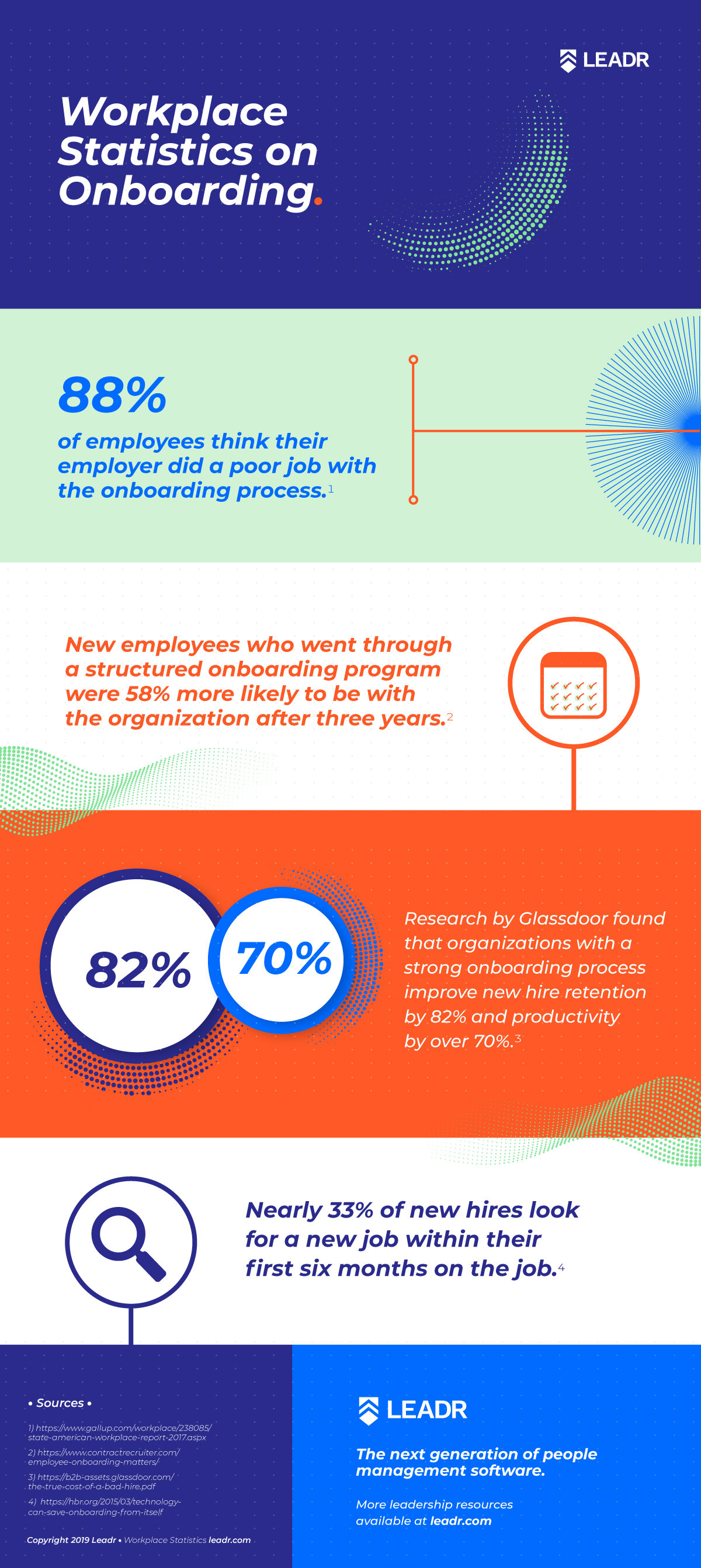
88% of employees think their employer did a poor job with the onboarding process.
-
Source: https://www.gallup.com/workplace/238085/state-american-workplace-report-2017.aspx
-
Conversation Prompt: What was your onboarding experience like at our company?
-
Action Item: What's one way we could improve our onboarding process?
“New employees who went through a structured onboarding program were 58% more likely to be with the organization after three years.”
-
Source: The Wynhurst Group
-
Conversation Prompt: Why do you think there's a link between structured onboarding and employee retention.
-
Action Item: How could we go back to existing employees and re-onboard them in order to increase retention?
“Many companies leave executive onboarding to chance, and as a result experience failure rates in excess of 50% when it comes to retaining new executive talent.”
-
Source: Egon Zehnder International
-
Conversation Prompt: What is one thing you believe our new executives should know or experience as part of their onboarding process?
-
Action Item: If we were to incorporate you and your department into executive onboarding, what tasks or projects would you want to share with them? Let’s discuss next week.
When new employees start at Zappos, they get an intensive five-week training course to learn about the company’s values and procedures, as well as an offer of $2,000 to quit if they don’t feel they are a good fit.
-
Source: Zappos CEO Tony Hsieh
-
Conversation Prompt: When did you start to feel like a good fit at our company?
-
Action Item: Make a list of our company’s top values and procedures. Let’s discuss next week.
Nearly 33% of new hires look for a new job within their first six months on the job.
-
Source: https://hbr.org/2015/03/technology-can-save-onboarding-from-itself
-
Conversation Prompt: Why do you think some new hires start job searching very early?
-
Action Item: What is one step you recommend we take to help reduce early employee turnover?
It typically takes eight months for a newly hired employee to reach full productivity.
-
Source: https://sloanreview.mit.edu/article/reinventing-employee-onboarding/
-
Conversation Prompt: How long did you work here before you reached full productivity?
-
Action Item: What can I do to help new members of this team reach productivity earlier in their tenure with us?
Organizations with a standard onboarding process experience 50% greater new-hire productivity.
-
Source: https://www.urbanbound.com/blog/onboarding-infographic-statistics
-
Conversation Prompt: Do you think this statistic is correct? Do you feel like a standard onboarding process is or would be helpful in improving productivity?
-
Action Item: If you could create an onboarding process for our team from the ground up, what would you include?
Research by Glassdoor found that organizations with a strong onboarding process improve new hire retention by 82% and productivity by over 70%.
-
Source: https://b2b-assets.glassdoor.com/the-true-cost-of-a-bad-hire.pdf
-
Conversation Prompt: Why do you think a strong onboarding process improves productivity?
-
Action Item: Do some research on the essential components of a strong onboarding process. Be prepared to share next week.
Gallup found that only 12% of employees strongly agree their organization does a great job of onboarding new employees.
-
Source: https://www.gallup.com/workplace/238085/state-american-workplace-report-2017.aspx
-
Conversation Prompt: Why do you think employers struggle to create great onboarding experiences?
-
Action Item: If we were to survey our own employees to determine what they thought about our onboarding, how would we go about doing that?
These statistics and conversations are just the beginning of what is possible when you initiate a structured coaching relationship between your managers and employees.
At Leadr, we believe better coaching develops stronger, more effective teams. Many managers, however, don't have the time to create and implement a structured coaching system. That's why we're creating a new kind of people management software that empowers managers with the tools they need to develop leaders at all levels of the organization. Request a demo now.
Share this
You May Also Like
These Related Stories

3 Ways To Become a Better Leader By Developing Your Personal Strengths

Who Leadr Is & What We Do




No Comments Yet
Let us know what you think